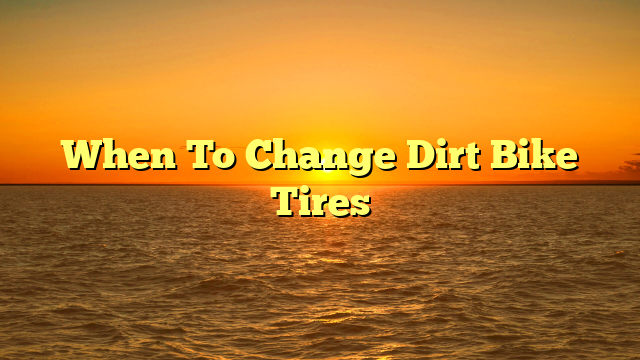Dirt bike tires are an essential component of your off-road riding experience.
They provide the necessary traction and stability required to tackle rough terrain and navigate through obstacles.
However, with time and use, these tires lose their effectiveness and become worn out, leading to a decrease in performance and safety.
Knowing when to replace your dirt bike tires is crucial for maintaining optimal riding conditions and preventing accidents.
This article aims to provide an in-depth understanding of the lifespan of dirt bike tires, factors affecting tire wear, signs of wear and tear, and the importance of regular inspections.
We will also discuss when to replace your tires, choosing the right tires for your riding style, maintaining your tires for optimal performance, and safety tips for riding with new tires.
By the end of this article, you will have a comprehensive knowledge of when to change your dirt bike tires to ensure a safe and enjoyable riding experience.
Table of Contents
- 1 Key Takeaways
- 2 Understanding the Lifespan of Dirt Bike Tires
- 3 Factors Affecting Tire Wear
- 4 Signs of Wear and Tear
- 5 Importance of Regular Inspections
- 6 When to Replace Your Tires
- 7 Choosing the Right Tires for Your Riding Style
- 8 Maintaining Your Tires for Optimal Performance
- 9 Safety Tips for Riding with New Tires
- 10 Frequently Asked Questions
- 11 Conclusion
Key Takeaways
- Regular tire maintenance is crucial for prolonging the lifespan of dirt bike tires.
- Proper tire pressure is essential for optimal performance and safety, with overinflation reducing traction and handling, and underinflation causing increased wear and tear.
- Terrain variability impacts tire lifespan, with rough and rocky terrain causing faster wear and tear.
- Tire replacement is recommended every 20-30 hours of riding time or at least once a year, and the cost comparison is important when choosing tires.
Understanding the Lifespan of Dirt Bike Tires
The lifespan of dirt bike tires is a critical factor to consider in determining when to change them, as it directly affects the performance and safety of the rider.
Dirt bike tires are designed to provide maximum traction and stability on rough terrains.
However, regular wear and tear can significantly affect their performance, leading to reduced grip and handling.
Therefore, it’s essential to maintain the tires adequately and keep a close eye on their condition to ensure safe and efficient riding.
Tire maintenance is crucial in prolonging the lifespan of dirt bike tires.
Maintaining proper tire pressure is a vital aspect of tire maintenance that ensures optimal performance and safety.
Overinflated or underinflated tires can lead to reduced grip, handling, and stability, increasing the risk of accidents.
It’s recommended to check the tire pressure before every ride and adjust it according to the manufacturer’s specifications.
Additionally, inspecting the tires for cuts, punctures, and wear can help identify potential issues early and prevent tire failure.
Factors Affecting Tire Wear
Several variables can impact the lifespan of dirt bike tires.
One of the most important factors is tire pressure.
Maintaining the right tire pressure is crucial to ensuring that the tires wear evenly and last longer.
Low tire pressure can cause the tires to wear out faster due to increased friction and heat generated by the tire.
On the other hand, overinflated tires can lead to reduced traction, poor handling, and uneven wear, which can ultimately shorten the lifespan of the tires.
Another factor affecting tire wear is terrain variability.
The type of terrain you ride on can have a significant impact on the lifespan of your tires.
Rough and rocky terrain can cause the tires to wear out faster than smoother, softer terrain.
Additionally, if you frequently ride on pavement or hard surfaces, your tires will wear out more quickly than if you stick to dirt or gravel trails.
It’s important to be mindful of the type of terrain you’re riding on and adjust your riding style accordingly to minimize the wear and tear on your tires.
Signs of Wear and Tear
One key consideration for riders is recognizing the indicators of tire degradation and wear over time.
Uneven tread wear is one of the most common signs that a tire needs replacement.
This is typically caused by improper inflation or misalignment and can lead to decreased traction and stability on the road.
Punctures are another common sign of wear and tear, as they can lead to slow leaks or blowouts.
Regular tire maintenance, such as checking for proper inflation and inspecting for punctures or other damage, can help prevent these issues from occurring and extend the life of the tire.
It is important for riders to be proactive in monitoring their tire wear and replacing them when necessary.
While there is no set timeframe for when to change dirt bike tires, recognizing signs of wear and tear can help riders make informed decisions about when to invest in new tires.
By regularly inspecting their tires for uneven tread and punctures, and performing routine maintenance, riders can ensure that their bikes are safe and performing at their best on the road.
Importance of Regular Inspections
Regular inspections are crucial for ensuring the safety and performance of a dirt bike’s tires.
Tire maintenance is an essential part of preventative care that should be conducted regularly to avoid unexpected tire failures.
Dirt bike tires are designed to provide maximum traction and stability, making them a critical component of a bike’s performance.
As such, it is crucial to conduct regular inspections to monitor wear and tear and ensure that the tires are in good condition.
One way to conduct regular inspections is to check the tire pressure and tread depth regularly.
Proper tire pressure ensures that the tires maintain their shape, which is essential for maintaining stability and reducing the risk of a blowout.
On the other hand, tread depth is crucial for maintaining traction and stability, particularly on slippery surfaces.
A tire with a worn-out tread is more prone to skidding and slipping, which can be dangerous for riders.
The following table highlights the recommended tire pressure and tread depth for dirt bike tires:
| Tire Pressure (PSI) | Front Tire Tread Depth (inches) | Rear Tire Tread Depth (inches) |
|---|---|---|
| 12-15 | 0.25-0.5 | 0.5-0.75 |
Preventative care, particularly tire maintenance, is crucial for ensuring the safety and performance of a dirt bike’s tires.
Regular inspections, such as checking tire pressure and tread depth, can help prevent unexpected tire failures and ensure that the tires are in good condition.
By conducting regular inspections and adhering to recommended tire pressure and tread depth, riders can ensure that their tires are in top condition for optimal performance and safety.
When to Replace Your Tires
Determining the appropriate time for tire replacement is critical in maintaining the safety and optimal performance of a dirt bike.
As a general rule, it is recommended to replace the tires every 20-30 hours of riding time or at least once a year, even if the tires still have a good amount of tread left.
However, several factors can affect the lifespan of the tires such as the type of terrain, the rider’s style, and the quality of the tires.
When it comes to tire replacement, cost comparison is also an essential aspect to consider.
While cheaper tires may seem like a more attractive option, they may not last as long or perform as well as pricier ones.
In the long run, investing in high-quality tires may actually save money by reducing the frequency of replacement and providing better performance on the track or trail.
It is always best to consult with a professional mechanic or tire expert to determine the best tires for your specific dirt bike and riding style.
Choosing the Right Tires for Your Riding Style
Selecting suitable tires for your individual riding style is crucial for achieving optimal performance and safety on a dirt bike.
When choosing dirt bike tires, there are several factors to consider.
One of the most important factors is tire pressure.
The recommended tire pressure for your dirt bike is typically listed in the owner’s manual or on the tire itself.
It is important to maintain the recommended tire pressure to ensure optimal handling and traction.
Low tire pressure can make the bike feel sluggish and unresponsive, while high tire pressure can lead to a harsh ride and reduced traction.
Another important factor to consider when choosing dirt bike tires is the tread pattern.
The tread pattern determines how well the tire grips the terrain and how well it sheds mud and debris.
Different tread patterns are designed for different riding styles and terrains.
For example, a tire with deep, aggressive knobs is ideal for muddy terrain, while a tire with closely spaced knobs is better suited for hard-packed dirt.
It is important to choose a tire with a tread pattern that matches your riding style and the terrain you will be riding on.
By considering these factors, you can choose the right tires for your dirt bike that will provide optimal performance and safety.
Maintaining Your Tires for Optimal Performance
Proper maintenance is essential for ensuring that your dirt bike tires perform optimally and remain safe.
One of the most important aspects of tire maintenance is monitoring and maintaining proper tire pressure.
Riding on underinflated or overinflated tires can lead to decreased performance, reduced traction, and even tire failure.
To ensure that your tires are properly inflated, check the tire pressure regularly with a tire pressure gauge.
The recommended tire pressure for your specific bike and tire type can be found in the owner’s manual or on the tire itself.
In addition to maintaining proper tire pressure, regular tire rotation is also important for extending the life of your tires and maintaining optimal performance.
Tire rotation involves switching the front and rear tires to ensure that they wear evenly.
This is especially important for dirt bikes, as the front tire typically wears faster due to the increased weight distribution on the front of the bike.
By rotating the tires, you can prevent uneven wear and extend the life of your tires.
It is recommended to rotate the tires every 10-15 hours of riding or after every race, depending on your riding style and conditions.
Safety Tips for Riding with New Tires
After discussing the importance of maintaining dirt bike tires for optimal performance, it is essential to address the safety tips for riding with new tires.
New tires require proper inflation and a breaking-in period before they can perform at their best.
Maintaining proper inflation is crucial because underinflated tires can cause loss of control and overheating, while overinflated tires can lead to harsh riding and reduced grip.
During the breaking-in period, new tires need to be ridden with caution and care.
The first 100 miles should be ridden at moderate speeds and with gradual braking to help the tires adjust to the road surface and wear evenly.
This process is essential for the tires to reach their optimal performance level while also ensuring rider safety.
By following these guidelines, riders can ensure that their new tires are performing to their fullest potential, providing the necessary grip and stability for a safe and enjoyable ride.
Frequently Asked Questions
Can I use car tires on my dirt bike?
Using car tires on a dirt bike presents safety concerns and is not recommended.
Car tires lack the necessary tread and size required for off-road riding.
While cost-effective, the pros do not outweigh the cons when it comes to this decision.
How often should I rotate my dirt bike tires?
Proper tire maintenance is essential to ensure optimal performance and longevity of dirt bike tires.
Regularly rotating the tires, at least every 8-10 hours of riding, is recommended to ensure even wear.
Additionally, tire pressure management is crucial to prevent tire damage and ensure proper traction.
What is the maximum lifespan of a dirt bike tire?
The maximum lifespan of a dirt bike tire varies depending on tire maintenance and wear patterns.
Factors such as proper inflation, regular cleaning, and avoiding hard impacts can extend tire life.
However, tire wear patterns can indicate when replacement is necessary.
Can I repair a punctured dirt bike tire or do I need to replace it?
When a dirt bike tire gets punctured, the decision to repair or replace it depends on the severity and location of the damage.
Patching options are available, but if the damage is extensive or in a critical area, replacement is recommended for safety reasons.
Is it necessary to replace both front and rear tires at the same time?
Replacing individual dirt bike tires can be done, but it is recommended to replace both front and rear tires at the same time to maintain bike balance and reduce wear.
The cost implications of replacing only one tire may result in uneven wear and decreased performance.
Conclusion
In conclusion, understanding when to change dirt bike tires is crucial for maintaining optimal performance and safety.
The lifespan of a tire depends on various factors, such as the type of terrain, riding style, and maintenance practices.
Regular inspections are essential for detecting signs of wear and tear, such as cracks, punctures, and uneven wear patterns.
Replacing your tires at the right time can prevent accidents and improve your riding experience.
Look for indicators like low tread depth, loss of grip, and visible damage to determine when it’s time to invest in new tires.
Choosing the right tires for your riding style is also important, as different tires are designed for different purposes and terrain types.
Finally, maintaining your tires by checking air pressure, cleaning, and storing them properly can prolong their lifespan and enhance their performance.
By following these guidelines, you can stay safe and get the most out of your dirt bike tires.







